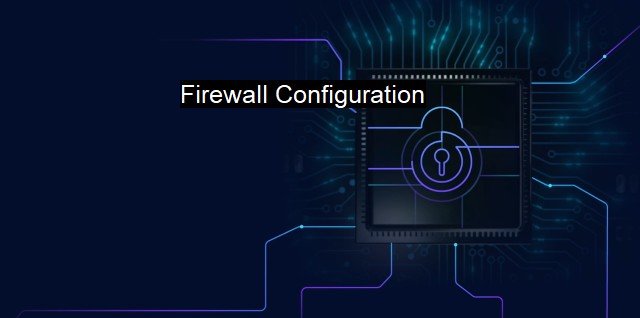What is Firewall Configuration?
Understanding Firewall Configuration and Its Crucial Role in Cybersecurity: A Comprehensive Guide for Businesses and Individuals
The term "firewall configuration" frequently arises due to its pivotal role in securing network infrastructures. Firewall configuration is a process that involves establishing and organizing an interface's control settings to safeguard a specific network or system. It vitally dictates what enters and exits a digital interface, thereby playing a paramount role in bolstering a system's defense mechanism against unauthorized access or unidentified threats.At its core, a firewall is designed to sift internet traffic and data packets in several necessary ways, such as port, protocol, or application. This network security system employs rules and norms, which are explicitly drawn out in the firewall configuration to examine and control inbound and outbound network traffic. Firewall rules essentially dictate if particular data should be blocked or allowed. Consequently, administrators can explicitly customize a firewall's defenses to meet their specific security needs.
Firewall configuration can broadly fall into two categories. One could be a host-based configuration, which hardens an individual device's security mechanism from threats originating from external networks or even other devices within a similar network. On the other hand, the network-based firewall configuration inferably guides overall network airflow, essentially determining which data and digital connections come in and out of the network.
The intricacies associated with firewall configuration recoils to a central firewall configurator guiding rule-set composing, especially vital when the network consists of multiple firewall units. Rule conflicts in such a scenario could jeopardize uniformity, orchestration, and most importantly, security. The rule-based part of configuration isn’t about blanketly blocking and allowing but considering nexuses like source/destination IP addresses or ports or other specific information about traffic packets before dictation. After the rules have been implemented, assessment iterations ensure the configuration hasn't rendered the network exclusively defenseless against future vulnerabilities or attacks.
One perfect example of various elements considered in firewall configuration is the direction of the traffic. Outbound traffic pertains to internal requests to external sources of data or services, such as accessing a website or streaming a movie on a popular entertainment platform. These requests presumably involve sending data packets. Correct bound-rules in configuration would decisively understand and pass legitimate requests while denying any undesired extraction of sensitive data, such as private user information or intellectual property out of the network.
Comparatively, inbound traffic pertains to data and connection requests from outside sources. If they're unsolicited, more often than not, they might be threats attempting to infiltrate the network, inspect its core, or jeopardize the housed data. Appropriately applied defense rules on this end block suspicious origin data packets, sometimes even indiscriminate data packets striving to protect the network.
Such versatility testifies configuration's clout in how a firewall performs. Whether it encompasses simplistic needs, like thwarting web traffic from suspicious websites, or fluctuates to more complex decrees, including assisting Virtual Private Networks and Intranets safeguard data while it moves between public and private company networks.
In antivirus context, Firewall configuration takes protocols to assess packet signatures and detect possible virus activity. Infected files are typically barred from entering, protecting the system. That's why meticulous Firewall configuration with an updated virus information database goes a long way in ensuring system security.
Firewall configuration symbolizes a highly detriment cornerstone within the broad security fort that is cyber defense. Given its importance, conscious configurators must establish person-specific strategies and perpetuate learning to never let the defenses falter in tandem with the ever-morphing threat landscape.

Firewall Configuration FAQs
What is firewall configuration and why is it important for cybersecurity?
Firewall configuration is the process of setting up a firewall to regulate traffic coming in and out of a network. It is important for cybersecurity because it helps prevent unauthorized access, blocks malicious traffic, and protects sensitive information.What are the different types of firewalls that can be configured for antivirus protection?
The different types of firewalls that can be configured for antivirus protection include packet filtering firewalls, application-level gateways, and proxy firewalls. Each type offers a unique set of features and benefits for blocking viruses and other malware.What factors should be considered when configuring a firewall for antivirus protection?
When configuring a firewall for antivirus protection, factors that should be considered include the types of traffic and applications that will be allowed, the level of security required, the types of threats that need to be blocked, and the size and complexity of the network.How can I ensure that my firewall configuration is effective in preventing antivirus threats?
You can ensure that your firewall configuration is effective in preventing antivirus threats by regularly monitoring and updating it, testing it periodically, and ensuring that it is configured to meet the latest industry standards and best practices. It is also important to educate users on safe browsing habits, and to regularly scan the network for viruses and other malware.| | A | | | B | | | C | | | D | | | E | | | F | | | G | | | H | | | I | | | J | | | K | | | L | | | M | |
| | N | | | O | | | P | | | Q | | | R | | | S | | | T | | | U | | | V | | | W | | | X | | | Y | | | Z | |
| | 1 | | | 2 | | | 3 | | | 4 | | | 7 | | | 8 | | |||||||